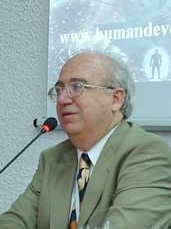Michael A. Cremo (born July 15, 1948), also known by his devotional name Drutakarmā dāsa, is an American freelance researcher who describes himself as a Vedic creationist and an "alternative archeologist."[1][2][3] He argues that humans have lived on Earth for millions of years.[4] Based on artifacts allegedly found in the Eocene auriferous gravels of Table Mountain, California and discussed in his book Forbidden Archeology, Cremo argues for the existence of modern humans on Earth as early as 30 to 40 million years ago. Forbidden Archeology, which he wrote with Richard L. Thompson, has attracted criticism from mainstream scholars, who describe it as pseudoscientific.[5][6][7]
Michael A. Cremo | |
|---|---|
 Cremo in 2003 lecturing in Bulgaria | |
| Born | July 15, 1948 Schenectady, New York, U.S. |
| Nationality | American |
| Alma mater | George Washington University |
| Occupation(s) | Author, editor |
| Website | www.MCremo.com |
Early life and education
editCremo was born in Schenectady, New York. Cremo's father, Salvatore Cremo, was a United States military intelligence officer. Michael Cremo lived with his family in Germany, where he went to high school. They spent several summers traveling throughout Europe. He attended George Washington University from 1966 to 1968, then served in the United States Navy.
Religious views
editCremo is a member of the International Society for Krishna Consciousness (ISKCON) and the Bhaktivedanta Institute. He has written several books and articles about Hindu spirituality using the pen-name Drutakarmā dāsa. He has also been a contributing editor to the magazine Back to Godhead and a bhakti yoga teacher. Cremo told Contemporary Authors that he decided to devote his life to Krishna in the early 1970s, after receiving a copy of the Bhagavad Gita at a Grateful Dead concert. In the end of the 1990s he authored a paper on the official ISKCON statement on capital punishment.[8] His work on "Puranic Time and the Archaeological Record" was published in ISKCON Communications Journal[9] and Time and Archaeology.[10]
Forbidden Archeology
editCremo's central claim in Forbidden Archeology is that humans have lived on Earth for tens to hundreds of millions of years, and that the scientific establishment has suppressed the fossil evidence of extreme human antiquity.[11] In case of grooved spheres from pyrophyllite mines of Ottosdal, South Africa, Cremo proposes that they might be man-made artifacts, possibly as far back as 2.8 billion years ago. Forbidden Archeology has been criticized by mainstream scholars from a variety of disciplines.[5]
Publications
edit- Thompson, Richard L.; Cremo, Michael A. (1993). Forbidden archeology : the hidden history of the human race (1st ed.). San Diego: Bhaktivedanta Institute. ISBN 9780963530981.
- Cremo, M A. (1999) "Puranic Time and the Archeological Record". In Tim Murray, ed. Time and Archaeology, Routledge, London,
- Cremo, M. A. (2002) "The Later Discoveries of Boucher de Perthes at Moulin Quignon and Their Impact on the Moulin Quignon Jaw Controversy". In Goulven Laurent ed. Proceedings of the XXth International Congress of History of Science (Liege, 20–26 July 1997), Volume X, Earth Sciences, Geography and Cartography. Turnhout, Belgium: Brepols, pp. 39–56
- Cremo, M. A. (2009) "The discoveries of Carlos Ribeiro: a controversial episode in nineteenth-century European archeology", Journal of Iberian Archaeology, vol. 12: 69-89.
- Cremo, M. A. (2008) "Excavating the eternal: an indigenous archaeological tradition in India", Antiquity, 82:178-188.
- Cremo, M. A. (2008) "Some Angles on the Anglo Debate", Archaeologies: Journal of the World Archaeological Congress, 4(1): 164-167.
Recent years
editIn recent years, Cremo has organized a number of conferences where ISKCON-associated academics exchanged views and experiences.[12] In March 2009, Cremo appeared in a History Channel television series called Ancient Aliens, and in 2010 in a mini series of the same name.[13]
See also
editReferences
edit- ^ Cremo, Michael A., "The Discoveries of Belgian Geologist Aimé Louis Rutot at Boncelles, Belgium: An Unresolved Archeological Controversy from the Early Twentieth Century", XIVth Congress of the International Union for Prehistoric and Protohistoric Sciences, Liège, Belgium, Sep. 2-8, 2001. Retrieved 23 June 2009.
- ^ Nanda, Meera. "Vedic creationism in America" Archived February 10, 2007, at the Wayback Machine, Frontline, Vol 23, Issue 01, Jan. 14 - 27, 2006 (India)
- ^ Cremo, Michael (2012). "An Insider's View of an Alternative Archeology". In Simandiraki-Grimshaw, Anna; Stefanou, Eleni (eds.). From Archaeology to Archaeologies: The 'Other' Past. Archaeopress. pp. 14–19. ISBN 9781407310077.
- ^ Morrow, Tom. "Forbidden Archeology's Impact by Michael A Cremo". RNCSE. 19 (3): 14–17.
- ^ a b Nanda, Meera "Postmodernism, Hindu Nationalism and 'Vedic Science'" in Koertge, Noretta (ed.) Scientific Values and Civic Virtues Oxford University Press USA (25 Aug 2005) ISBN 978-0195172256 Quote: "This remarkable compendium of pseudoscience [Forbidden Archeology] is premised on the assumption that modern science is a prisoner of Western cultural and religious biases..."
- Tarzia, Wade (1994). "Forbidden Archaeology: Antievolutionism Outside the Christian Arena". Creation/Evolution. 34: 13–25.
- Wodak, J. and Oldroyd, D. (1996) "Vedic creationism": a further twist to the evolution debate. Social Studies of Science, 26: 192–213 (quoted passages, p. 196, 206-207)
- Morrow, Tom. Review of Forbidden Archeology's Impact by Michael A Cremo. RNCSE 19 (3): 14–17
- ^ Creationism: The Hindu View, Colin Groves
- ^ Bradley T. Lepper, Hidden History, Hidden Agenda, Talk Origins
- ^ "Position Statements - ISKCON News Weekly". iskcon.com. Archived from the original on February 23, 2012. Retrieved February 20, 2009.
- ^ "Puranic Time and the Archaeological Record". www.iskcon.com. Archived from the original on June 16, 2013. Retrieved February 20, 2009.
- ^ Cremo, M.A., 1999. "Puranic time and the archaeological record", In T. Murray (ed.), Time and Archaeology 38-48. London: Routledge
- ^ "Michael (A.) Cremo". Contemporary Authors. September 23, 2002. Retrieved on August 17, 2008
- ^ "ISKCON Academy of Arts and Sciences conference (2006) at Bhaktivedanta College". www.bhaktivedantacollege.com.
- ^ Erbs, Lori. "Drutakarma Dasa Featured on The History Channel". news.iskcon.com. Retrieved March 7, 2009.